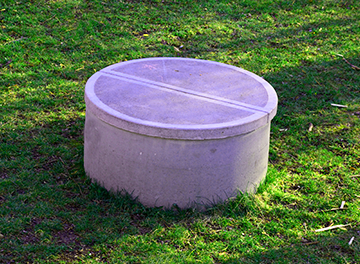Epidemiology: Occupational and Environmental
Private Wells: Test Results

Public water supply systems are regulated by national and state laws like the Clean Water and Safe Drinking Water Act. A public supply system is defined as a system that has at least 15 connections or regularly serves at least 25 individuals. These laws require these systems, which can be publicly or privately owned, to maintain certain quality standards established by law. However, there are no laws that regulate the quality of individual household wells.
Standards Used by the State Lab
The State Laboratory of Public Health tests individual household wells by the same standards used for public water sources. They use the U.S. Environmental Protection Agency's National Primary Drinking Water Regulations, or primary standards, for levels of certain potentially harmful substances and microorganisms which may be in public drinking water systems. They also use the National Secondary Drinking Water Regulations, or secondary standards, for contaminants that may cause aesthetic changes to water by affecting the appearance, odor, or taste.
The U.S. Environmental Protection Agency has established the Maximum Contaminant Level Goal (MCLG). This is a non-enforceable health benchmark goal which is set at a level at which no known or anticipated adverse health effect on the health of persons is expected to occur and which allows an adequate margin of safety.
A Maximum Contaminant Level (MCL) is the highest level of a contaminant that is allowed in drinking water by law. These are set as close to the MCLG as feasible using the best available analytical and treatment technologies and taking cost into consideration. Maximum Contaminant Levels are enforceable standards.
Both MCLGs and MCLs are measured in either milligrams per liter (mg/L) or micrograms per liter (µg/L). Milligrams per liter are equivalent to parts per million (PPM); micrograms per liter are parts per billion (PPB).
What To Expect
Private well water samples are submitted to the State Lab through the local health department. The test results are returned to the local health department within three (3) weeks.
For microbial contaminants like coliform bacteria or the parasite that causes cryptosporidiosis, the results will indicate whether the analyte is "Present" or "Absent". No measurement of the amount of the contaminant(s) will be included because the presence of any of the five (5) microbial contaminants in any quantity means that the water is unsafe for drinking.
- EPA: Primary Drinking Water Regulations - Microorganisms
In the case of chemical contaminants, the results will provide the concentration level of each contaminant detected by the test. If the contaminant is not found at all in the sample, the result will be "Not Detected". In some cases, the amount of the contaminant in the water sample is so small that the analytical devices in the laboratory cannot provide a numerical result. These values are referred to as "Below Detect" or "Trace".
- EPA: Primary Drinking Water Regulations - Inorganic Chemicals
- EPA: Primary Drinking Water Regulations - Organic Chemicals
Analyzing Your Results
You will also receive a results analysis prepared by a toxicologist in the Environmental Epidemiology Branch. The analysis explains whether your well water meets state and federal drinking water standards. If your well water is contaminated, the analysis will include recommendations for re-testing and whether your water can continue to be used for other household tasks such as bathing, showering, and washing clothes and dishes.
Private Wells Pages
Related OEEB Programs
- Chemical Preparedness and Response Surveillance (ChPRS) Program
- Health Assessment, Consultation and Education Program
- Medical Evaluation and Risk Assessment Program
Additional Resources
Last Modified: November 17, 2021
